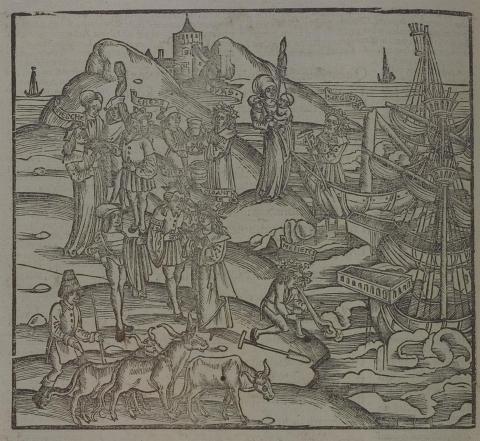Annotations
In this image, Aeneas awards prizes to the participants of the boat race. At the bottom of the image, a man herds three bullocks toward the ships (247). In the middle of the image, Aeneas places a crown of laurel on Cloanthus, the winner of the boat race (245-6); a boy hands Cloanthus his prize, a richly embroidered cloak (250-7). Above this and to the left, Aeneas, with the help of two slaves, presents the second place winner, Mnesthus [Mnesche] with what is supposed to be a coat of mail (258-65), rendered entirely in cross-hatching, and thus barely visible. To the right of this scene, a man presents a set of cauldrons and bowls to Gyas, who came in third (266-7). On the right, Sergestus brings his broken ship into the harbor holding a single oar, and a slave woman with twin boys standing on the shore is his prize (268-85). In the lower right, Menetes, the pilot of Cloanthus, who got knocked off the ship by the impatient Cloanthus, has swam to shore and now sits coughing up water (178-80). (Katy Purington)
Woodcut illustration from the “Strasbourg Vergil,” edited by Sebastian Brant: Publii Virgilii Maronis Opera cum quinque vulgatis commentariis expolitissimisque figuris atque imaginibus nuper per Sebastianum Brant superadditis (Strasbourg: Johannis Grieninger, 1502), fol. 237v, executed by an anonymous engraver under the direction of Brant.


Sebastian Brant (1458-1521) was a humanist scholar of many competencies. Trained in classics and law at the University of Basel, Brant later lectured in jurisprudence there and practiced law in his native city of Strasbourg. While his satirical poem Das Narrenschiff won him considerable standing as a writer, his role in the transmission of Virgil to the Renaissance was at least as important. In 1502 he and Strasbourg printer Johannes Grüninger produced a major edition of Virgil’s works, along with Donatus’ Life and the commentaries of Servius, Landino, and Calderini, with more than two hundred woodcut illustrations. (Annabel Patterson)